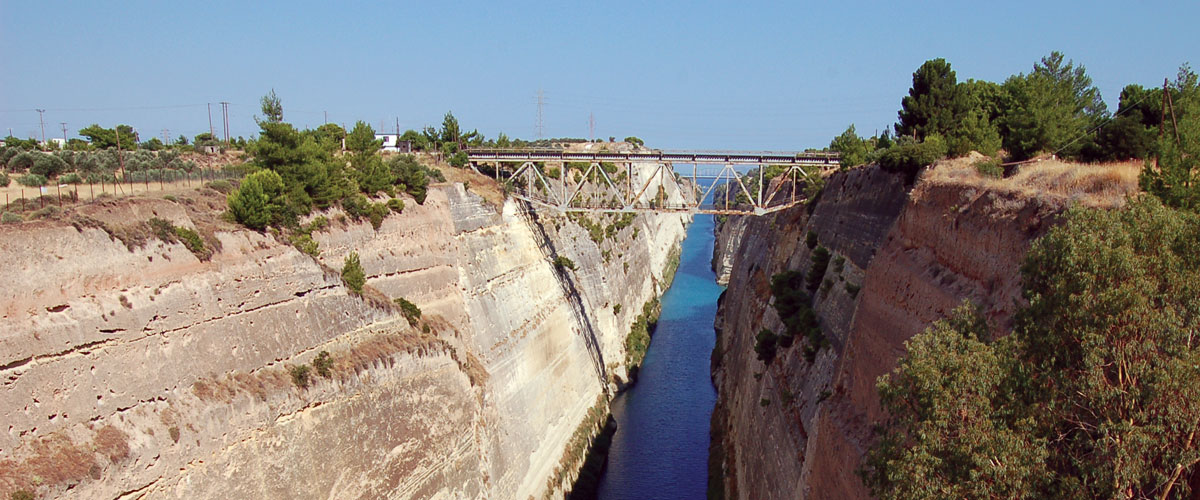
The idea of uniting the Saronic and the Corinthian gulfs is very old and it practically took more than 25 centuries to be completed. The tyrant of Corinth Períandros, one of the 7 sages of antiquity (the other 6 were: Thales of Miletus, Pittacus of Mytilene, Bias of Priene, Solon of Athens, Cleobulus of Rhodes and Chilon of Sparta), around 620 BC, was the first to consider the building of a canal, due to the problems posed when transporting goods via land.
Períandros initially constructed an overland stone ramp, named Díolkos, as a portage road, i.e. a road designed for goods or vessels to be carried overland, between two bodies of water. Díolkos was a paved road on which the ships of that era, coated with fat, slid on top of wooden bars in order to cross from one coast to the other. The very expensive tolls the merchants had to pay to Corinth, was the most important income of the city. Parts of Díolkos can be seen even today, running parallel to the existing canal towards the N. Since 1960, the ancient Díolkos is being restored.
According to historians, Períandros abandoned his plans of building a canal between the 2 gulfs for mainly 2 reasons. First, the technical difficulties of such a task imposed a very significant construction and financial challenge. Besides, the muscular power of the slaves and the animals was adequate to transport the triremes, which were ships of a small size and weight (comparable to the size and weight of a large sailing yacht of today).
Second, he was afraid to cause the wrath of the gods, due to the oracle of Pythía, saying “do not fortify or dig the Isthmus. Zeus built islands where he deemed it necessary” (the word “isthmus” comes from the Ancient Greek word for “neck” and means a narrow piece of land connecting two larger areas across an expanse of water). It is very possible that this oracle existed to protect the priests of the several temples, who received rich gifts and offerings from the merchants during their stay in Corinth city (which financially exploited Díolkos).
Three centuries after Períandros, in 307 BC., Dimítrios the Besieger called Egyptian mechanics to advise him on opening the channel. However, the Egyptians convinced him that the sea level between the two gulfs was different and an intersection on land joining them, would inevitably result to flooding the Saronic and drowning Aígina and the surrounding coasts.
During the Roman Years, Julius Caesar (44 BC.) and Caligula (37 BC.) both involved themselves with the opening of the Corinth canal, but their plans did not come to fruition because of military and political reasons. The Roman emperor Nero, who wanted to surpass the achievements of Hercules by separating two lands, order the beginning of the works in 66 AD. Thousands of workers, among which 6000 captured pirates, were placed along the line of the isthmus and emperor Nero declared the task started by hitting a rock with his golden pickax. The works stopped when Nero had to return to Rome to deal with the uprising of general Galba. With Nero’s death, one year later, the task was abandoned.
At the Byzantine years, the trading routes were different and Pelopónnisos had passed to the background. Thus, there was never a (financially) strong enough “motive” to continue the works for the canal. During the Venetian rule, (commercial) importance started to come back to Peloponnese, so the Venetians attempted to continue the work on the canal, from the side of the Corinthian gulf this time. But again, the small time the Venetians occupied the area and the difficulties they encountered (translated as “bad omen”) led to a premature stop.
The next person to consider opening the Corinth Canal was the first, after the Wars of Hellenic Independence, prime minister Kapodístrias in 1830. However, the limited state budget did not allow for the expenditure of 40 million French francs, as estimated for the completion of the works.
In the next years, the task was coming closer and closer to fruition, step by step, up until the 23rd of April 1882, when the Corinth Canal works officially started, with the help of the man behind the construction of the Suez canal, Ferdinand de Lesseps. After 8 years of continuous work, the project came to a halt because of inability to further fund it.
The continuation of the works took over a Greek company under Andréas Syggrós, who finally managed to complete it. The technical achievement of opening a channel between Pelopónnisos and the rest of Greece, using 2500 workers and the finest mechanical equipment of the era, was completed after 11 years and the opening ceremony was held in the 25th of July 1893, with the prime minister Sotíris Sotirópoulos.



